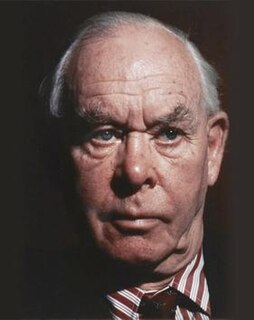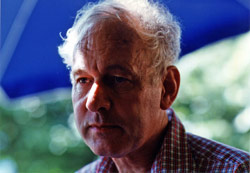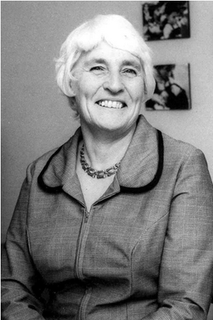
Wilfred Ruprecht Bion DSO was an influential English psychoanalyst, who became president of the British Psychoanalytical Society from 1962 to 1965.

Melanie Klein was an Austrian-British author and psychoanalyst known for her work in child analysis. She was the primary figure in the development of object relations theory. Klein suggested that pre-verbal existential anxiety in infancy catalyzed the formation of the unconscious, resulting in the unconscious splitting of the world into good and bad idealizations. In her theory, how the child resolves that split depends on the constitution of the child and the character of nurturing the child experiences; the quality of resolution can inform the presence, absence, and/or type of distresses a person experiences later in life.

Edward John Mostyn Bowlby, CBE, FBA, FRCP, FRCPsych was a British psychologist, psychiatrist, and psychoanalyst, notable for his interest in child development and for his pioneering work in attachment theory. A Review of General Psychology survey, published in 2002, ranked Bowlby as the 49th most cited psychologist of the 20th century.

The Tavistock and Portman NHS Foundation Trust is a specialist mental health trust based in north London. The Trust specialises in talking therapies. The education and training department caters for 2,000 students a year from the United Kingdom and abroad. The Trust is based at the Tavistock Centre in Swiss Cottage. The founding organisation was the Tavistock institute of medical psychology founded in 1920 by Dr. Hugh Crichton-Miller.
David Huntingford Malan was a British psychoanalytic psychotherapy practitioner and researcher recognized for his contribution to the development of psychotherapy. He promoted scientific spirit of inquiry, openness, and simplicity within the field. He is also noted for his development of the Malan triangles, which became a rubric in which therapists can reflect upon what they are doing and where they are in relational space at any given moment.
Frances Tustin was a pioneering child psychotherapist renowned for her work with children with autism in the 1950s. She became a teacher and began studying psychoanalysis in 1943 at the University of London.
Child psychotherapy, or mental health interventions for children have developed varied approaches over the last century. Two distinct historic pathways can be identified for present-day provision in Western Europe and in the United States: one through the Child Guidance Movement, the other stemming from adult psychiatry or psychological medicine, which evolved a separate child psychiatry specialism.
Donald Meltzer (1922–2004) was a Kleinian psychoanalyst whose teaching made him influential in many countries. He became known for making clinical headway with difficult childhood conditions such as autism, and also for his theoretical innovations and developments. His focus on the role of emotionality and aesthetics in promoting mental health has led to his being considered a key figure in the "post-Kleinian" movement associated with the psychoanalytic theory of thinking created by Wilfred Bion.

Eric Rhode is a British writer on traditional cosmology and psychoanalysis.
The Chicago Psychoanalytic Institute is a center for psychoanalytic research, training, and education on Michigan Avenue in downtown Chicago. The institute provides professional training in the theory and practice of psychoanalysis and psychotherapy. It was founded in 1932 by Franz Alexander, a pioneer in psychosomatic medicine at the Berlin Psychoanalytic Institute, who moved to Chicago at the invitation of Robert Maynard Hutchins, then president of the University of Chicago. Notable psychoanalysts that have been associated with the institute include Karl Menninger, Karen Horney, Thomas Szasz, Therese Benedek, Hedda Bolgar, Roy Grinker, Maxwell Gitelson, Louis Shapiro, Heinz Kohut, Arnold Goldberg, Jerome Kavka, Frank Summers, Ernest A. Rappaport, and Michael Franz Basch.
Martha Harris, née Dunlop was a British Kleinian psychoanalyst of children and adults. From 1960 to 1980 she was head of the Child Psychotherapy service at the Tavistock Clinic, taking over from Esther Bick, who had established a foundational method of disciplined infant observation. Harris was responsible for the subsequent expansion in the number of English and international trainees at the Tavistock, and for laterally developing the training into what became known as the Tavi Model. This model, in which infant observation continues to play a pre-eminent role, has been adopted, with modifications, in other European countries and in South America: such as the GERPEN in France, the six Martha Harris Study Centres in Italy, and the São Paulo Mother-Baby Study Centre in Brazil.
Edna O'Shaughnessy was a South African-born British Kleinian psychoanalyst.
Esther Bick, (1902–1983), born in Przemyśl, Galicia, Poland, was a psychologist and child and adult psychoanalyst who, with Dr. John Bowlby, established the child and adolescent psychotherapy training program at the Tavistock Clinic, London, in 1948.
Psychodynamic Therapy with Infants and Parents aims to relieve emotional disturbances within the parent(s), the baby, and/or their interaction, for example, postnatal depression and anxiety, infant distress with breastfeeding and sleep, and attachment disorders. It rests on attachment theory and psychoanalysis. Sigmund Freud suggested that a modification of his method could be applied to children, and child analysis was introduced in the 1920s by [Anna Freud].., [Melanie Klein], and Hermine Hug von Hellmuth. Klein speculated on infantile experiences to understand her patients' disorders but she did not practice PTIP. Donald Winnicott, a pediatrician and analyst, focused on the mother-baby interplay in his theorizing and his brief parent-child consultations, but he did not work with PTIP.

Joyce Robertson was a British psychiatric social worker, child behavioural researcher, childcare pioneer and pacifist, who was most notable for changing attitudes to the societally acceptable, institutionalised care and hospitalisation of young children, that was prevalent. In the late 1940s Robertson worked with Anna Freud first at the Well Baby Clinic and later in the Hampstead Child Therapy Clinic. She was later joined by her husband James Robertson. In 1965, both of them moved to the Tavistock Institute of Human Relations to work with John Bowlby on the Young Children in Brief Separation project and the development of attachment theory. This was to research the mental state and psychological development of children who underwent brief separation from their parents. Later in her career, Robertson worked with her husband to produce a series of celebrated documentary films that highlighted the reaction of small children who were separated from their parents. These were shown in hospitals, foster care and state run hospitals. Later she was known for promoting the idea of foster care instead of residential nurseries.
Child Guidance was both an evolving 20th-century social construct, sometimes called the Child Guidance Movement, and an influential network of multidisciplinary clinics set up to address the problems of childhood and adolescence. It began in the United States and after World War I spread rapidly to Europe, especially to England, though not to Scotland. It was the first child-centred institutional response to meet perceived child and youth behavioural and mental disorders. It therefore predated the advent of child psychiatry as a medical specialism and of distinct child psychiatric departments as part of modern hospital settings.
The Society of Analytical Psychology, known also as the SAP, incorporated in London, England, in 1945 is the oldest training organisation for Jungian analysts in the United Kingdom. Its first Honorary President in 1946 was Carl Jung. The Society was established to professionalise and develop Analytical psychology in the UK by providing training to candidates, offering psychotherapy to the public through the C.G. Jung Clinic and conducting research. By the mid 1970s the Society had established a child-focused service and training. The SAP is a member society of the International Association for Analytical Psychology and is regulated by the British Psychoanalytic Council.
The British Psychotherapy Foundation, Bpf, is the successor organisation to three former long-established British psychotherapy providers and clinical training institutions which merged in April 2013. The original constituents are the British Association of Psychotherapists, BAP (1951), The Lincoln Clinic and Centre for Psychotherapy (1968) and the London Centre for Psychotherapy, LCP, (1976). It is unique in the United Kingdom for providing treatment services for children and adults in all the psychoanalytic modalities, that is of Freudian and Jungian inspiration. It is also unique in providing professional training in those modalities within one institution and is regulated by the British Psychoanalytic Council. It has charitable status. Its current associations are:

Dana Amir is a full professor at Haifa University, clinical psychologist, psychoanalyst, poetess and literature researcher.
Anne-Marie Sandler is a Swiss-born British psychologist and psychoanalyst noted for her clinical observation of the relationship dynamic between blind infants and their mothers in a project spearheaded by Anna Freud.










